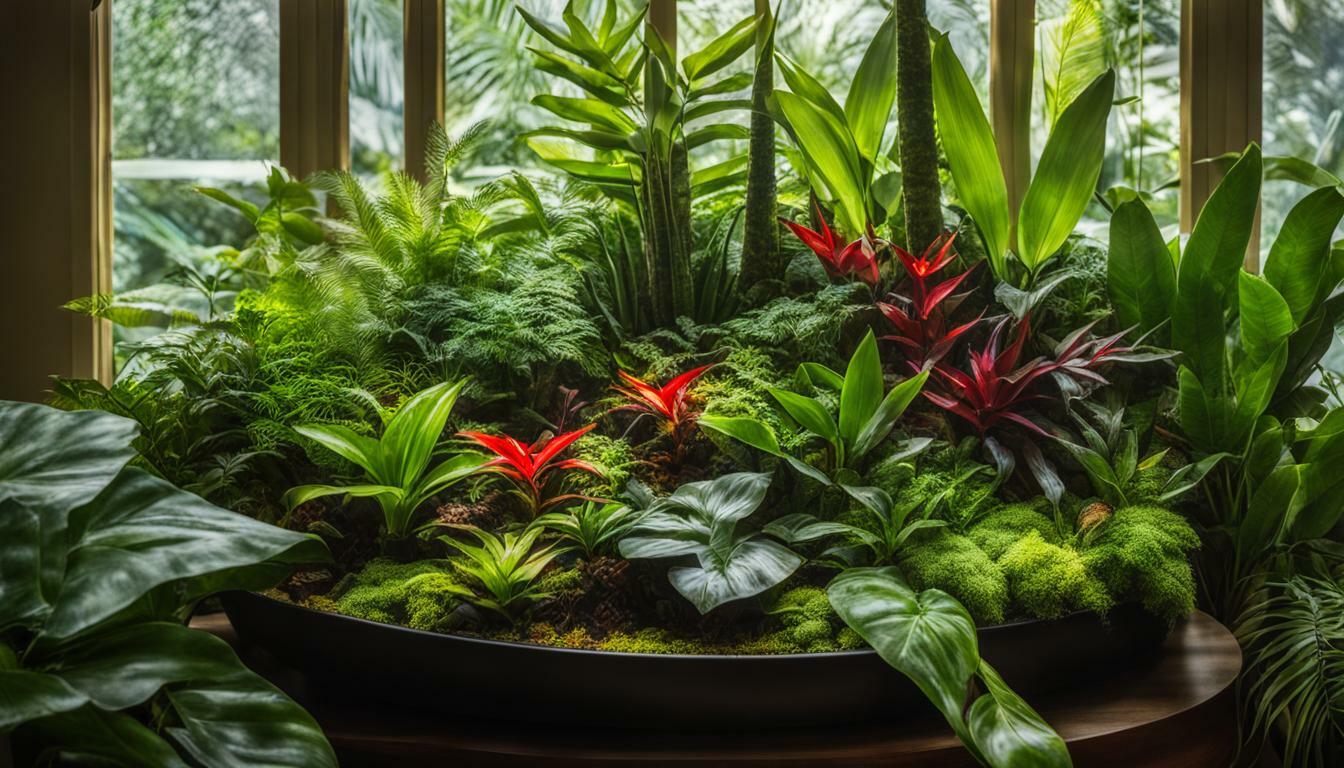Terrariums are a popular choice for bringing natural beauty into homes and offices, and tropical plants are particularly sought after for their lush foliage and vibrant colors. Whether you’re looking to add a touch of greenery to your living room or create a calming atmosphere in your workspace, tropical terrarium plants are a perfect choice.
With their ability to thrive in high humidity and moist soil, tropical plants are well-suited for the enclosed environment of a terrarium. Plus, they require minimal maintenance, making them an ideal option for busy individuals who want to enjoy the beauty of nature without the hassle of constant care.
Key Takeaways:
- Terrariums are a popular choice for adding natural beauty to homes and offices.
- Tropical plants are known for their lush foliage and vibrant colors.
- Tropical terrarium plants thrive in high humidity and moist soil.
- They require minimal maintenance, making them ideal for busy individuals.
- Tropical plants are a great way to create a calming and visually pleasing atmosphere.
With the wide variety of tropical terrarium plants available, you can easily find the perfect combination to suit your personal style and space. So, why not bring a little slice of tropical paradise into your home or office with these stunning plants?
Types of Terrariums
Before diving into the world of tropical terrarium plants, it’s important to understand the different types of terrariums available, including desert, tropical, and woodland options. Each type has its own unique characteristics, allowing you to create a personalized and captivating miniature ecosystem.
Desert terrariums are perfect for those who love the arid beauty of the desert. These terrariums typically feature cacti and succulents that thrive in dry, well-draining soil. The minimalistic beauty of desert terrariums makes them an excellent choice for any space.
Tropical terrariums are known for their lush foliage and vibrant colors. These terrariums mimic the warm and humid environments of the tropics, making them the ideal habitat for tropical plants such as ferns, orchids, and bromeliads. With their stunning beauty and rich biodiversity, tropical terrariums can bring a touch of exotic paradise into your home or office.
Woodland terrariums recreate the enchanting atmosphere of a forest floor. These terrariums typically feature plants that thrive in shaded and moist environments. Ferns, mosses, and small flowering plants are popular choices for woodland terrariums, creating a serene and mystical ambiance.
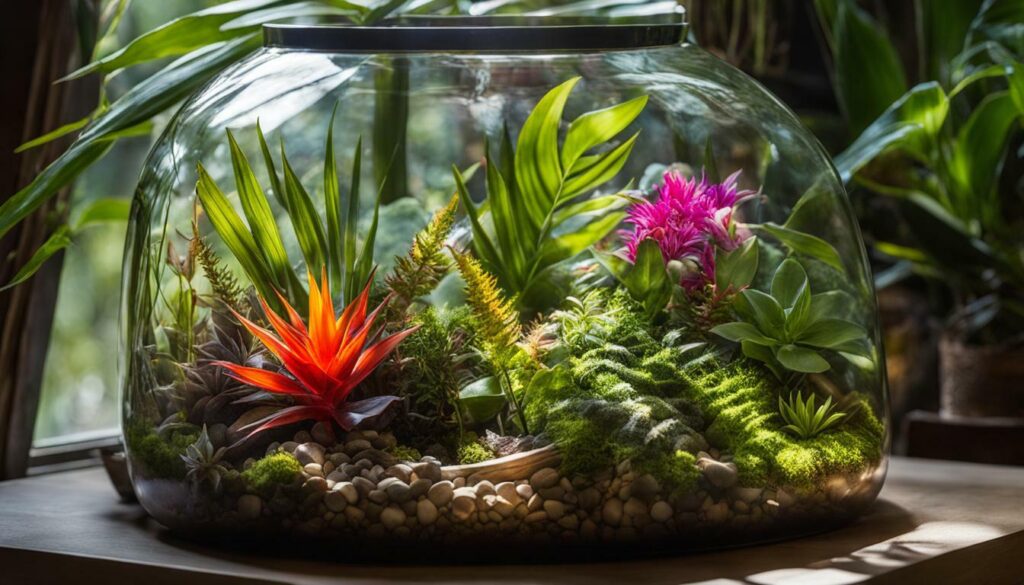
Creating a terrarium allows you to unleash your creativity and showcase your love for nature. Whether you prefer the stark beauty of desert terrariums, the lushness of tropical terrariums, or the enchantment of woodland terrariums, there is a terrarium type suited for every taste and space.
Choosing Tropical Terrarium Plants
When it comes to selecting plants for your tropical terrarium, there are several factors to take into account, including the plant’s height, texture, and color, as well as its suitability for a humid and moist terrarium environment. These factors will not only enhance the visual appeal of your terrarium but also ensure that the plants thrive in their new habitat.
First, consider the height of the plants. Choose a variety of plants with different heights to create depth and dimension within your terrarium. Taller plants can act as focal points, while shorter ones can provide a lush ground cover. This variation in height will add visual interest and create a more natural-looking environment.
Next, think about the texture of the plants. Opt for a mix of plants with different leaf shapes and textures. This will create a visually dynamic terrarium, with leaves ranging from smooth and glossy to rough and textured. The contrasting textures will add depth and complexity to the overall design.
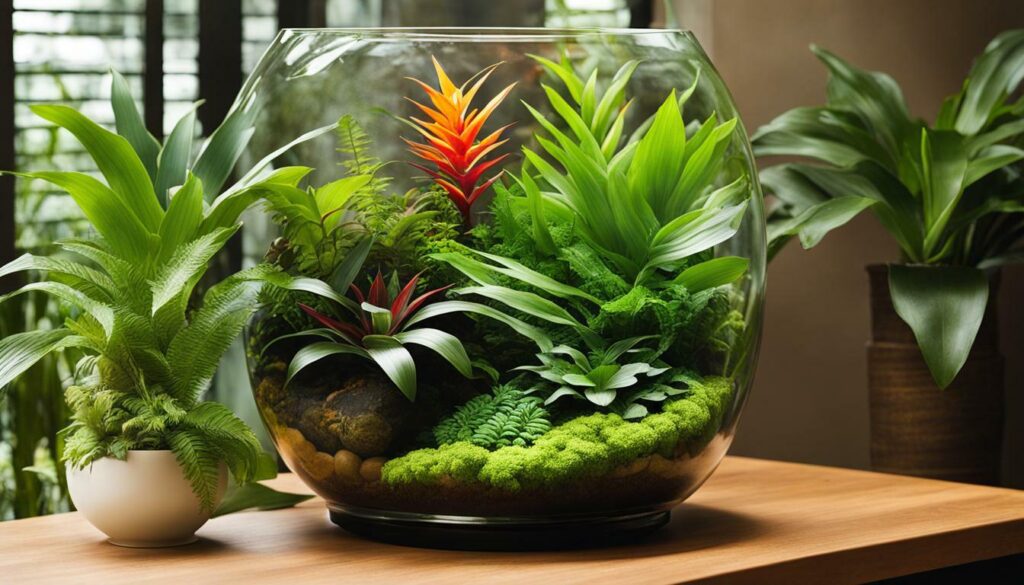
Lastly, consider the color palette of the plants. Tropical terrariums often feature vibrant and bold colors. Choose plants with foliage in various shades of green, as well as plants with colorful blooms or unique patterns. The combination of different colors will create a visually stunning and captivating terrarium display.
| Plant | Height | Texture | Color |
|---|---|---|---|
| Ficus pumila (Creeping Fig) | Low | Small, lush leaves | Green |
| Macodes petola (Lightning Jewel Orchid) | Medium | Textured, velvety leaves with intricate patterns | Green with orange highlights |
| Asplenium nidus ‘Crispy Wave’ (Bird’s Nest Fern) | Medium | Long, wavy fronds | Bright green |
By considering the height, texture, and color of the plants, you can create a tropical terrarium that is not only visually stunning but also provides a suitable environment for the plants to thrive. Remember to choose plants that are well-suited for high humidity and moist soil, as these conditions are essential for their growth and health.
Now that you have a better understanding of how to choose tropical terrarium plants, you can create a mini tropical paradise in your home or office. Get creative with your plant selection and create a terrarium that showcases the beauty and diversity of tropical flora.
Recommended Tropical Terrarium Plants
When it comes to choosing tropical plants for your terrarium, consider including Ficus pumila, Macodes petola, Asplenium nidus ‘Crispy Wave’, Neoregelia, Humata heterophylla, and Bulbophyllum orchids, as they are well-suited for thriving in tropical terrarium environments. These plants not only add a touch of natural beauty, but also provide a lush and vibrant atmosphere to your space.
Ficus pumila, also known as Creeping Fig, is a popular choice for its trailing vines and small, dark green leaves. It is a fast-growing plant that can quickly fill up vertical spaces in your terrarium, creating a lush and dense backdrop. Macodes petola, or Lightning Jewel Orchid, features stunning foliage with intricate patterns that resemble lightning bolts, adding a touch of exotic beauty to your terrarium.
Asplenium nidus ‘Crispy Wave’, also known as Bird’s Nest Fern, is a tropical fern with wavy, glossy leaves that add texture and depth to your terrarium. Neoregelia, a type of Bromeliad, comes in various colors and patterns, making it a great choice for adding pops of vibrant hues to your terrarium. Humata heterophylla, commonly known as Rabbit’s Foot Fern, has delicate, fuzzy leaves that create a unique and interesting texture in your terrarium. Bulbophyllum orchids, with their intricate blooms and long-lasting flowers, add a touch of elegance and sophistication to your tropical terrarium.
To enhance the variety of your tropical terrarium, consider adding other plant options like Syngonium podophyllum ‘Pixie’, Anubias barteri var. nana ‘Petite’, or the Crocodile Fern. These plants offer unique characteristics such as variegated leaves, compact size, and distinct foliage patterns that contribute to the overall aesthetics of your terrarium.
Complete the look of your tropical terrarium by incorporating tropical moss. The lush and vibrant greenery of tropical moss not only adds visual appeal but also helps to create a more natural and realistic environment for your plants to thrive. The addition of tropical moss enhances the overall aesthetics, providing a lush and vibrant tropical feel to your terrarium.
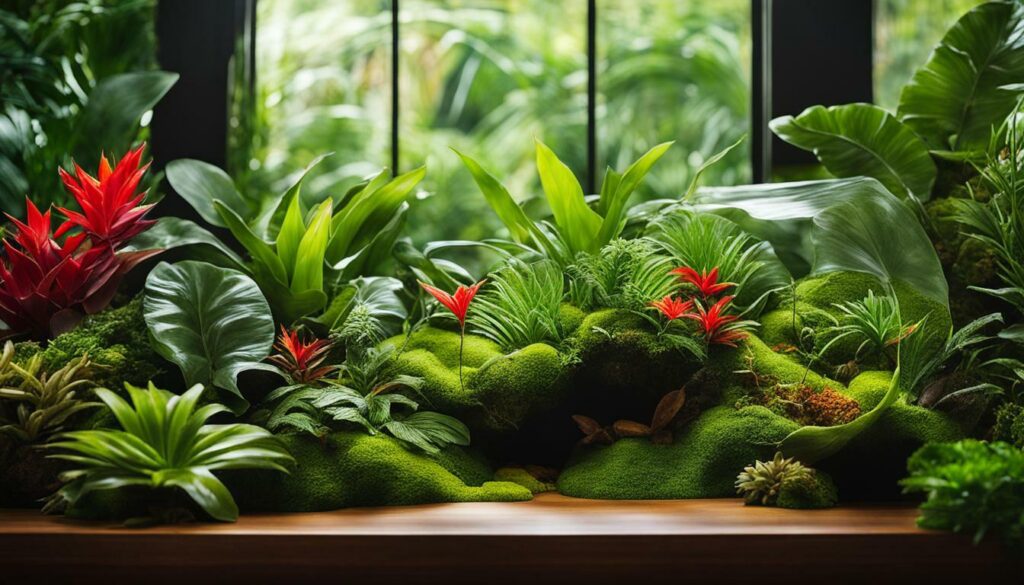
| Tropical Plant | Common Name | Description |
|---|---|---|
| Ficus pumila | Creeping Fig | Fast-growing plant with trailing vines and small, dark green leaves. |
| Macodes petola | Lightning Jewel Orchid | Exotic plant with stunning foliage featuring intricate patterns resembling lightning bolts. |
| Asplenium nidus ‘Crispy Wave’ | Bird’s Nest Fern | Tropical fern with wavy, glossy leaves that add texture and depth to your terrarium. |
| Neoregelia | Bromeliad | Colorful tropical plant with various hues and patterns, perfect for adding vibrancy to your terrarium. |
| Humata heterophylla | Rabbit’s Foot Fern | Delicate plant with fuzzy leaves that create a unique texture in your terrarium. |
| Bulbophyllum orchids | Orchids | Elegant and sophisticated orchids with intricate blooms and long-lasting flowers. |
Additional Options for Tropical Terrariums
In addition to the recommended plants mentioned earlier, you may also consider including Syngonium podophyllum ‘Pixie’, Anubias barteri var. nana ‘Petite’, and Crocodile Fern in your tropical terrarium for added diversity and visual appeal. These plants have their own unique characteristics that can enhance the overall aesthetics of your terrarium.
Syngonium podophyllum ‘Pixie’ is a popular choice with its delicate, arrow-shaped leaves that come in various shades of green. Its compact size makes it perfect for small terrariums, and its trailing vines add a touch of elegance.
Anubias barteri var. nana ‘Petite’ is a slow-growing plant that thrives in low-light conditions, making it ideal for terrariums with limited access to natural light. Its dark green, heart-shaped leaves create a beautiful contrast against other plants in the terrarium.
The Crocodile Fern is known for its unique frond pattern, resembling the scales of a crocodile. Its vibrant green foliage adds texture and visual interest to any terrarium. This fern prefers higher humidity levels, making it a great choice for tropical terrariums.

| Plant | Scientific Name | Characteristics |
|---|---|---|
| Syngonium podophyllum ‘Pixie’ | Arrow-shaped leaves in various shades of green, compact size, trailing vines. | Perfect for small terrariums |
| Anubias barteri var. nana ‘Petite’ | Dark green, heart-shaped leaves. | Thrives in low-light conditions |
| Crocodile Fern | Unique frond pattern resembling crocodile scales. | Thrives in higher humidity levels |
These additional options will not only add variety to your tropical terrarium but also create a visually appealing and vibrant green oasis within your home or office.
Completing the Look with Tropical Moss
To truly capture the essence of a tropical environment in your terrarium, don’t forget to include tropical moss as it adds a finishing touch and completes the natural look. Tropical moss, with its lush green color and delicate texture, creates a vibrant and visually appealing atmosphere within the terrarium. It not only enhances the aesthetics but also provides numerous benefits for the plants and overall terrarium ecosystem.
Tropical moss, such as Java moss (Taxiphyllum barbieri) or Peacock moss (Selaginella uncinata), thrives in the high humidity and moist soil conditions that are ideal for tropical terrariums. It acts as a natural sponge, absorbing excess moisture and maintaining a consistent humidity level. This is especially important for tropical plants that require a humid environment to thrive. The moss also helps to retain moisture in the soil, preventing it from drying out too quickly.
Furthermore, tropical moss provides a soft and comfortable substrate for the plants, allowing their roots to anchor securely and absorb nutrients effectively. It creates a natural carpet-like effect, adding depth and dimension to the terrarium. Additionally, the moss can serve as a natural filter, absorbing and purifying the air by trapping dust particles and harmful toxins.
When incorporating tropical moss into your terrarium, be mindful of its placement. Consider creating a moss bed or lining the base of the terrarium with a layer of moss. You can also use it to cover rocks, branches, or other decorative elements within the terrarium to give them a more natural appearance. The possibilities are endless and allow for creativity in designing your own tropical paradise.
| Moss Type | Scientific Name | Moisture Level | Lighting Requirements |
|---|---|---|---|
| Java Moss | Taxiphyllum barbieri | High | Low to Medium |
| Peacock Moss | Selaginella uncinata | High | Low to Medium |
| Christmas Moss | Vesicularia montagnei | High | Low to Medium |
By including tropical moss in your terrarium, you can create a lush and captivating tropical environment that will thrive and bring joy for years to come.
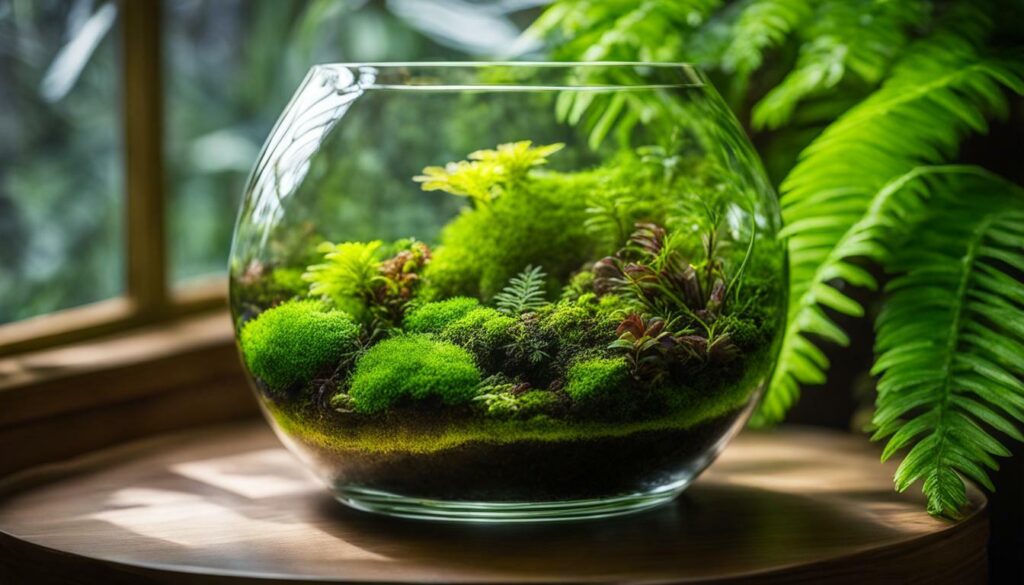
Creating a high humidity environment and ensuring moist soil are crucial for the success of tropical terrarium plants, as they are accustomed to such conditions in their natural habitats. These plants thrive in areas with consistent moisture and high humidity levels, replicating the tropical rainforest environment they are native to.
To maintain the ideal humidity level, it is important to keep the terrarium tightly sealed to trap moisture inside. This can be achieved by using a glass container with a well-fitting lid or cover. Regular misting of the plants and the terrarium walls will also help to create a humid atmosphere.
In terms of soil, tropical terrarium plants prefer a moist but well-draining substrate. It is recommended to use a mixture of peat moss, perlite, and orchid bark to provide adequate moisture retention while preventing waterlogging. This combination allows for proper aeration and prevents the roots from becoming waterlogged, which can lead to root rot.
Humidity and Moisture Requirements for Tropical Terrarium Plants
Below is a table summarizing the humidity and moisture requirements for common tropical terrarium plants:
| Plant | Ideal Humidity Level | Moisture Requirements |
|---|---|---|
| Ficus pumila (Creeping Fig) | 60-80% | Moist but well-draining soil |
| Macodes petola (Lightning Jewel Orchid) | 70-80% | Moist soil, avoid waterlogged conditions |
| Asplenium nidus ‘Crispy Wave’ (Bird’s Nest Fern) | 70-80% | Moist soil, avoid waterlogging |
| Neoregelia (Bromeliad) | 50-70% | Keep the central rosette filled with water |
| Humata heterophylla | 60-80% | Moist but well-draining soil |
| Bulbophyllum orchids | 70-80% | Moist but well-draining soil, avoid waterlogging |
By providing the necessary humidity and moisture conditions, you can ensure the health and longevity of your tropical terrarium plants. Regularly monitor humidity levels and soil moisture to make any necessary adjustments, ensuring your plants thrive in their miniaturized tropical oasis.
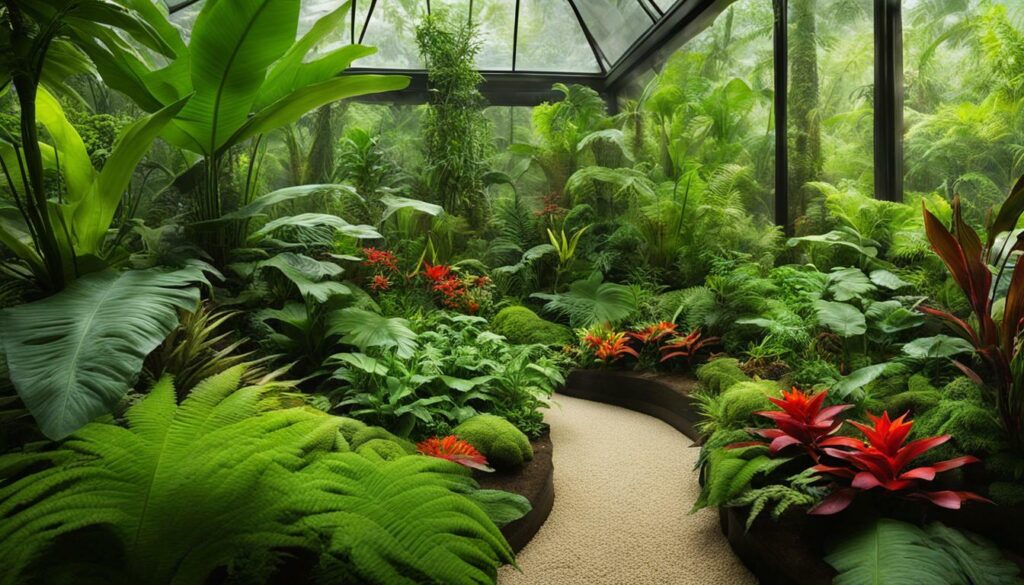
If you’re looking to purchase terrarium plants, whether tropical or otherwise, there are numerous options available both online and at local nurseries. Here are some resources to help you find the perfect plants for your terrarium:
- Online retailers: Many online stores specialize in selling terrarium plants. They offer a wide variety of plants to choose from, and you can conveniently browse and order from the comfort of your own home. Some popular online retailers for terrarium plants include:
- Green Thumb Plants
- Terrarium World
- Indoor Gardens
Before making a purchase, it’s important to research the specific needs and care requirements of the plants you’re interested in. Consider factors such as light, water, temperature, and humidity to ensure the plants will thrive in your terrarium environment. With the right resources and a little bit of planning, you’ll be well on your way to creating a beautiful and thriving terrarium.
| Online Retailer | Website |
|---|---|
| Green Thumb Plants | www.greenthumbplants.com |
| Terrarium World | www.terrariumworld.com |
| Indoor Gardens | www.indoorgardens.com |
You don’t have to limit yourself to just one source when searching for terrarium plants. It can be beneficial to explore multiple options to find the best quality, variety, and pricing. Remember to also check with local plant enthusiasts and experts for recommendations and advice.
So whether you prefer the convenience of online shopping or the hands-on experience of visiting a nursery, there are plenty of ways to find the perfect terrarium plants to bring life and beauty to your indoor space.
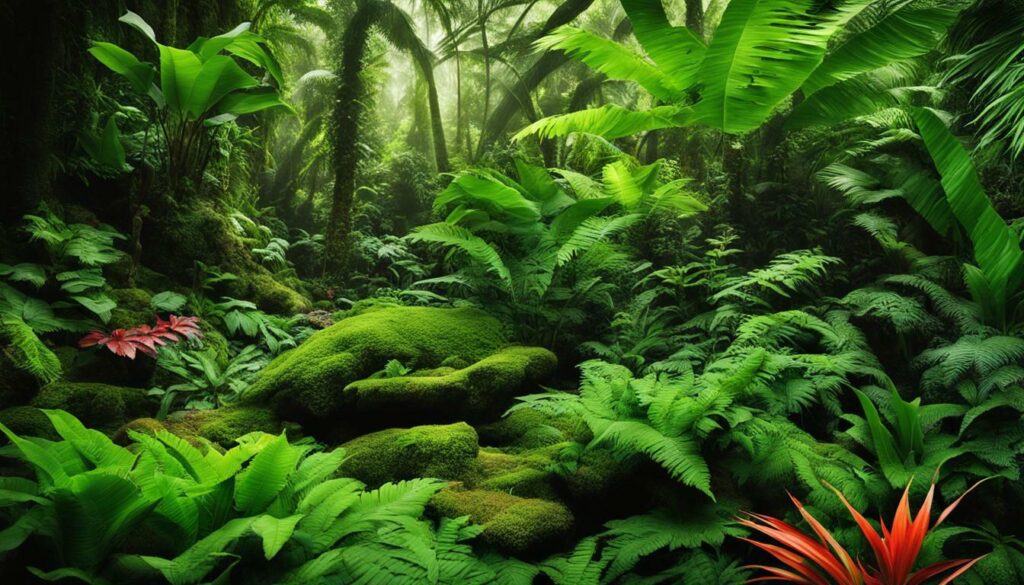
Maintaining a tropical terrarium doesn’t have to be a complicated task, especially when you choose low maintenance plants and follow a few simple plant care tips. These tips will help you create a thriving indoor ecosystem that brings the beauty of the rainforest right into your home or office.
1. Light: Most tropical terrarium plants thrive in bright, indirect light. Place your terrarium near a window where it can receive filtered sunlight or use artificial grow lights to mimic natural lighting conditions.
2. Watering: The key to successful watering is to keep the soil evenly moist, but not soggy. Use a spray bottle or mister to mist the plants and soil regularly, ensuring that the humidity level is maintained. Monitor the moisture level by touching the soil with your finger – if it feels dry, it’s time to water.
3. Pruning: Regular pruning is essential to maintain the shape and size of your terrarium plants. Trim any yellow or dead leaves, as well as any overgrown stems or branches. This will promote healthy growth and prevent overcrowding within the terrarium.
4. Fertilizing: Tropical terrarium plants benefit from regular fertilization. Use a balanced liquid fertilizer diluted to half strength, and apply it once a month during the growing season. Be careful not to over-fertilize, as this can lead to nutrient burn and damage the delicate ecosystem of the terrarium.
| Plant | Light Requirements | Watering Needs | Special Care |
|---|---|---|---|
| Ficus pumila (Creeping Fig) | Indirect sunlight | Keep moist, but not wet | Train vines to climb |
| Macodes petola (Lightning Jewel Orchid) | Filtered sunlight | Mist regularly to maintain humidity | Avoid direct sunlight |
| Asplenium nidus ‘Crispy Wave’ (Bird’s Nest Fern) | Indirect light or shade | Keep soil evenly moist | Avoid overwatering |
With these simple plant care tips, you can enjoy the beauty of a tropical terrarium without the hassle of high maintenance. Create your own miniature rainforest and bring a touch of exotic nature into your space.
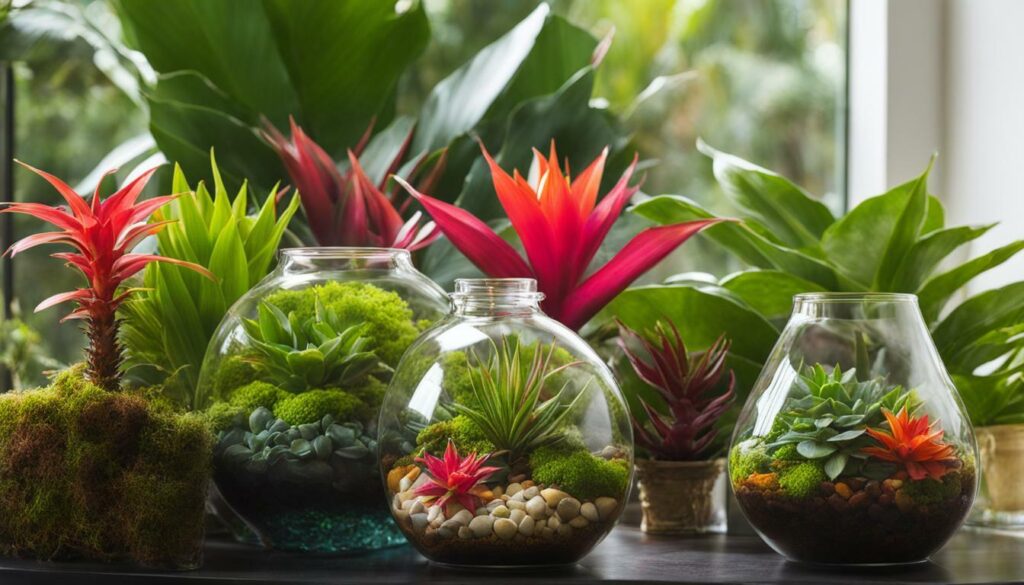
Conclusion
Incorporating tropical terrarium plants into your home or office can enhance the aesthetics and bring a touch of natural beauty to your space. Terrariums, whether desert, tropical, or woodland, offer an easy and low-maintenance way to enjoy the wonders of nature indoors.
When selecting plants for a tropical terrarium, it’s important to consider their height, texture, and color to create a visually appealing arrangement. Some recommended options include the versatile Ficus pumila (Creeping Fig), the stunning Macodes petola (Lightning Jewel Orchid), and the elegant Asplenium nidus ‘Crispy Wave’ (Bird’s Nest Fern). Neoregelia, Humata heterophylla, and Bulbophyllum orchids also add unique beauty to any tropical terrarium.
For those looking to go beyond the ordinary, additional options like Syngonium podophyllum ‘Pixie’, Anubias barteri var. nana ‘Petite’, and the exotic Crocodile Fern can further elevate the aesthetics of a tropical terrarium. Completing the look with tropical moss adds a touch of lushness and authenticity.
Tropical terrarium plants thrive in high humidity and moist soil, making them ideal for closed terrarium environments. By creating the right conditions and providing proper care, these plants will flourish and transform your home or office into a vibrant tropical oasis, bringing you closer to nature even when indoors.
Are Miniature Bamboo Plants Suitable for Terrariums in Home and Office Settings?
Yes, miniature bamboo terrarium plants are perfect for home and office settings. These small, low-maintenance plants thrive in the controlled environment of a terrarium. They add a touch of greenery and tranquility to any space, making them a popular choice for indoor decoration.
FAQ
Are terrariums suitable for both homes and offices?
Yes, terrariums can be a great addition to both homes and offices, providing a touch of natural beauty to any space.
What are the three primary types of terrariums?
The three primary types of terrariums are desert, tropical, and woodland.
What factors should I consider when selecting plants for a tropical terrarium?
When selecting plants for a tropical terrarium, consider factors such as height, texture, and color. It’s important to choose plants that thrive in high humidity and moist soil.
Can you provide a list of recommended tropical terrarium plants?
Certainly! Some recommended tropical terrarium plants include Ficus pumila (Creeping Fig), Macodes petola (Lightning Jewel Orchid), Asplenium nidus ‘Crispy Wave’ (Bird’s Nest Fern), Neoregelia (Bromeliad), Humata heterophylla, and Bulbophyllum orchids.
Are there any additional options for tropical terrariums?
Yes, there are additional options for tropical terrariums, such as Syngonium podophyllum ‘Pixie’, Anubias barteri var. nana ‘Petite’, and Crocodile Fern. These plants can add variety and interest to your terrarium.
Why is tropical moss important for a tropical terrarium?
Tropical moss helps to complete the natural look of a tropical terrarium. It adds a lush and tropical feel to the overall aesthetics of the terrarium.
How can I create a high humidity and moist soil environment for tropical terrarium plants?
To create a high humidity and moist soil environment, you can mist the terrarium regularly and use a well-draining soil mix. It’s important to monitor the moisture levels and adjust as needed.
Where can I find terrarium plants for purchase?
You can find terrarium plants for sale online through various plant retailers and marketplaces. Local nurseries may also carry a selection of terrarium plants.
What are some expert plant care tips for tropical terrariums?
Some expert plant care tips for tropical terrariums include watering only when the soil feels dry, providing bright but indirect light, and keeping an eye out for any signs of pests or diseases.

